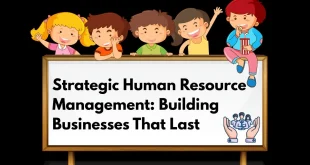It’s easy to think the Sustainable Development Goals are for governments, NGOs, or maybe big corporations with sustainability teams. But over the last few years, I’ve realized something—the real drivers of change sit inside our own offices.
Thank you for reading this post, don't forget to subscribe!In boardrooms. In policy documents. In HR departments.
For years, HR was seen as a support system—managing payroll, settling disputes, maybe organizing that annual retreat. But today, HR professionals are being called to do something much bigger: to shape how companies treat people, impact communities, and even care for the environment.
That’s not an exaggeration. Whether we’re talking about gender equity, mental health, or climate awareness — these are all HR issues now. And if businesses want to stay relevant (or even just survive the next decade), aligning with the SDGs is no longer a nice-to-have. It’s a must.
What the Sustainable Development Goals (SDGs) Really Mean for Companies
The Sustainable Development Goals (SDGs), set by the United Nations, are essentially 17 big-picture targets — from quality education to clean energy — that aim to make the world a better place by 2030.
Now, what does this have to do with HR?
Everything.
Let’s take a few examples:
- Good Health and Well-being (Goal 3): If your company has a mental health policy, supports healthy work hours, and promotes emotional wellness, you’re already contributing.
- Gender Equality (Goal 5): Equal pay, respectful workplaces, maternity support, leadership roles for women — these sit squarely with HR.
- Decent Work and Economic Growth (Goal 8): Are you creating fair jobs, reskilling employees, or promoting internal mobility? That’s you again.
- Climate Action (Goal 13): It may sound like an ops issue, but promoting green behavior at work (from digital paperwork to eco-friendly commuting) often starts with HR culture.
These are not abstract ideals. These are workplace-level practices that build responsible companies from within
Real Examples from Indian Companies
Let’s make this more real.
- Infosys has deeply integrated sustainability into its training programs. Their HR team runs learning modules on energy efficiency and even encourages employees to lead “green office” initiatives.
- Tata Group has blended inclusive hiring with skilling programs in rural areas. HR doesn’t just recruit — it builds pipelines for future talent, especially from underrepresented communities.
- Mahindra & Mahindra includes climate awareness and SDG alignment in its leadership programs. The idea? Build leaders who think beyond profit.
These aren’t CSR activities. These are talent strategies — designed and delivered by HR.
How HR Teams Can Actually Embed Sustainable Development Goals (SDGs)
Here are a few real actions HR teams can take — without waiting for top-down approval:
1. Hire for Purpose
Instead of hiring only for experience, look for people who want to solve social problems. Build diverse teams, especially by reaching out to underrepresented groups.
2. Train with Impact
Design programs that cover more than technical skills. Offer workshops on unconscious bias, green habits at work, or emotional intelligence.
3. Recognize What Really Matters
Reward employees who mentor juniors, reduce waste, or volunteer for causes. Recognition systems shape what employees focus on.
4. Make Policies More Human
Flexible work options, paid volunteering days, menstrual leave, mental health support — these are all policy levers that HR controls.
5. Measure and Report Progress
Don’t wait for an ESG team. Use basic HR data to track gender ratios, promotion fairness, upskilling hours, etc. Share it openly.
Quote of Note: “Sustainability is no longer about doing less harm. It’s about doing more good.” — Jochen Zeitz, Chairman and CEO, Harley-Davidson
HR as a Business Enabler, Not Just a Department
In many companies, HR still waits for management to lead on sustainability. But the truth is, HR is often the only department that touches every employee, every day. If we’re serious about changing work culture, HR can’t wait. It must lead.
That means:
- Challenging old ideas about success
- Educating leadership teams on the value of sustainable people strategies
- Partnering with CSR and ESG teams
- Asking hard questions in board meetings
We’re no longer just recruiters or compliance officers. We’re change-makers. And we need to start acting like it.
Final Thoughts: Time to Get Practical
Here’s the takeaway: aligning HR with the SDGs isn’t about ticking boxes. It’s about reimagining workplaces that are future-ready, employee-friendly, and community-conscious.
You don’t need a global team or massive budgets to begin. You just need intent.
Your move: Choose one SDG. Start a conversation in your HR team. Run a pilot program. Measure it. Improve it. Then scale it.
Big change starts with small steps.
FAQs: Sustainable Development Goals in HR
Q1: How can HR teams align with SDGs?
By hiring inclusively, updating policies for well-being, tracking ethical metrics, and engaging employees in community projects.
Q2: Are SDGs only for large companies?
No. Even small businesses can run green campaigns, support gender equity, and adopt ethical hiring.
Q3: What are the most HR-relevant SDGs?
Goals 3 (Health), 5 (Gender Equality), 8 (Decent Work), and 10 (Reduced Inequality) are most tied to HR.
 hroptimum
hroptimum



